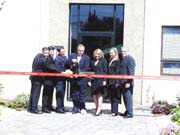With Mayor David Roberts cutting the ceremonial ribbon, a new three-story 80,000 square-foot “Business Center” at 50 Harrison St. opened its doors Tuesday.
According the JDA Development, the property’s owners and developers, the three-story building has 56 Class A office suites ranging from 650 square feet to 1,650 square feet. They will be leased to small firms, businesses and professionals.
This project could be an economic engine and spur commercial growth on the formerly mostly industrial west side. It is one of the city’s few commercial developments that caters specifically to small businesses and professionals, and the opening represents one of the first visible signs of the coming of the light rail on the city’s western border.
The project is also an attractive reuse of a former wax paper and Scott Paper towel factory.
For smaller businesses
In the past few years, Hoboken has experienced expansive growth in Class A commercial office space. The Waterfront Corporate Center on the city’s southern waterfront recently opened a second 13-story building, and those two buildings total around 1 million square feet of commercial office space.
While these new developments are universally considered a boon for the local economy, with job production and host of other positive economic impacts, they are not tailored for small professional firms and practices. Very few local accountants, doctors, architects or lawyers have firms large enough to take up an entire floor in the massive corporate towers. And the number of commercial ventures for small business has severely lagged behind the luxury apartments in Hoboken, giving rise to the perception of the city as a “bedroom community.”
“When we were researching [how to develop the site], we saw that there were few new office buildings in Hoboken that had small suites,” said developer Gregory Dell’Aquila Tuesday. “There was plenty of space for large corporate tenants but nothing for smaller firms. We believe that [this project] goes a long way to filling that niche.”
Dell’Aquila added that while many corporate projects are having problems filling their space, there is a regional need for small, quality commercial office space.
Roberts said that his administration encourages this type of commercial development in Hoboken. “We believe that the development of commercial office space is a worthwhile venture,” said Roberts. “It creates jobs and brings people into Hoboken to shop in our stores and eat in our restaurants.”
The only other new development in the city that offers Class A office space catering to local professionals is the Lyric Theater building on Hudson Street that is almost completed.
Developing the city’s west side
For nearly the past century, the city’s west side has been full of thick-walled factories with plate-glass windows, storage yards and tractor-trailer parking lots.
But the coming of the Hudson-Bergen Light Rail brings skyrocketed property values, and there is a promise of a commercial and residential renaissance for the once forgotten industrial area. The 21.5-mile light rail train line now runs from 45th Street in Bayonne through Jersey City to southern Hoboken, and will ultimately continue north into Bergen County.
Within the next year, the light rail stations at Second and Ninth streets next to the Palisades are scheduled to open. The segment will run from the Hoboken train station to the Weehawken ferry terminal. The Second Street station will be only steps away from the Hoboken Business Center.
“The light rail was definitely a motivating factor for us,” said Dell’Aquila, who added that the west side used to be virtually inaccessible to mass transit and will shortly be tied into the region’s best transportation network. “You can’t underestimate the importance of being connected to Newport,” said Dell’Aquila. “Now larger corporations will, for the first time, be able take advantage of lower rents on Hoboken’s west side for ‘back office’ space.”
Also, he said, that the light rail will serve as a means to transport employees and customers to his project.
The newly opened business center was originally a Cut-Rite wax paper factory that was built in 1935. In the past 70 years, the factory was home to Scott Paper Towels, My-T-Fine Pudding and a women’s clothes manufacturer.
“Rehabilitating [a former factory building] is a tough thing,” said Dell’Aquila. “There have been so many unforeseen challenges along the way. Once you think you’re done, you encounter something new.”
